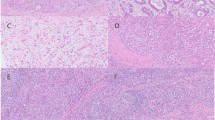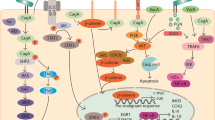Abstract
Epstein–Barr virus has been associated with a proportion of typical gastric adenocarcinomas. Here we report that the prevalence of Epstein–Barr virus in gastric adenocarcinomas from the United Kingdom is one of the lowest in the World. Gastric adenocarcinoma is another tumour whose association with Epstein–Barr virus varies with the population studied.
Similar content being viewed by others
Main
An early report that the Epstein–Barr virus (EBV) was present in the majority of lymphoepithelial-like carcinomas (LELCs) of the stomach, a rare form of gastric neoplasia (Shibata et al, 1991), was followed by the detection of EBV in 16% of typical gastric adenocarcinomas (Shibata and Weiss, 1992). The subsequent finding of monoclonal EBV episomes (Imai et al, 1994; Ott et al, 1994) and transforming proteins (zur Hausen et al, 2000) not only suggested an aetiological role for this virus in these tumours, but also the possibility that immunotherapy, for example CTL-based anti-EBV therapies (Rooney et al, 1998) might prolong survival for patients with virus-positive tumours. Before investing in such a strategy it is necessary to determine the numbers of patients who are likely to benefit. Here we report the largest survey of the prevalence of EBV in gastric adenocarcinomas undertaken outside Asia.
Materials and methods
The base population comprised 497 consecutive patients who were first diagnosed with gastric adenocarcinoma between 1993–1999 and who had their tumours resected in one of three hospitals from the West Midlands, UK. This series was supplemented by an additional 69 patients with unresected disease in whom the diagnosis was made on gastric biopsy. Eight cases were excluded when histopathological review could not confirm the original diagnosis and 24 because there was insufficient material for the preparation of tissue arrays. EBV status was determined on the remaining 534 patients. All exclusions were from resected cases.
A 4 mm-diameter needle was used to sample representative tumour areas from paraffin blocks using a modification of the method described by Kononen et al (1998). Twenty cylindrical tumour cores were positioned in 5 mm holes cut from a 2.5 × 3 cm piece of paraffin-embedded liver tissue. Four micron thick sections cut from the array were adhered to Vectabond® coated slides and in situ hybridisation for the detection of the EBV-encoded RNAs (EBERs) performed according to standard methods (Wu et al, 1990). Positive controls which included cores from known EBV-positive gastric cancers were seeded into arrays. Seventy-five which tested negative for EBERs in tissue arrays, were re-evaluated by in situ hybridisation of the originating tissue blocks. U6 and sense control probes were included in all runs and assays were performed in duplicate.
Results
The mean age of patients in this series was 65.4 years (range 34–87 years). The male to female ratio was 2.2 : 1. Among 465 patients with resected disease 214 (46%) were classified as intestinal type according to the criteria of Lauren (1965), 112 (24%) were diffuse, 108 (23%) mixed and 31 (7%) were unclassifiable. One hundred and sixty-two (35%) of resected tumours involved the cardia, 289 (62%) the corpus/antrum, two (0.4%) the gastric stump and in 12 (2.6%) subsite was unknown. EBERs were detected in 9 out of 534 (1.7%) tumours in eight patients with resected disease and in one of those diagnosed on gastric biopsy. Both gastric stump cancers were EBV-positive.
Discussion
The prevalence of EBV-positive cancers in this series of gastric adenocarcinomas is substantially less than that reported elsewhere (Table 1). We believe this is not the result of sampling error in the preparation of the tissue arrays because re-evaluation of EBER-negative tumours using the originating tissue blocks revealed no false-negatives and our findings are similar to those reported in two smaller studies also undertaken in the UK which used tissue blocks when testing for the presence of EBERs (Rowlands et al, 1993; Shousha and Luqmani, 1994).
Although a higher detection rate of EBV-positive tumours has been reported in other European series, estimates are based on comparatively small numbers of cancers with only 10 tumours in total testing positive for EBV. No patient in our series was found to have a LELC. These tumours are strongly associated with EBV and both gastric LELC and LELCs at other sites are more common in Asia (Gaffey and Weiss, 1990). The higher rate of detection of EBV in gastric adenocarcinomas observed in large Asiatic series suggests that gastric tumours are another site of cancer where the strength of the association with EBV varies with the population studied.
Change history
16 November 2011
This paper was modified 12 months after initial publication to switch to Creative Commons licence terms, as noted at publication
References
Chang MS, Kim WH, Kim CW, Kim YI (2000) Epstein-Barr virus in gastric carcinomas with lymphoid stroma. Histopathology 37: 309–315
Chapel F, Fabiani B, Davi F, Raphael M, Tepper M, Champault G, Guettier C (2000) Epstein-Barr virus and gastric carcinoma in Western patients: comparison of pathological parameters and p53 expression in EBV-positive and negative tumours. Histopathology 36: 252–261
Gaffey MJ, Weiss LM (1990) Viral oncogenesis: Epstein-Barr virus. Am J Otolaryngol 11: 375–381
Galetsky SA, Tsvetnov VV, Land CE, Afanasieva TA, Petrovichev NN, Gurtsevitch VE, Tokunaga M (1997) Epstein-Barr virus-associated gastric cancer in Russia. Int J Cancer 73: 786–789
Harn HJ, Chang JY, Wang MW, Ho LI, Lee HS, Chiang JH, Lee WH (1995) Epstein-Barr virus-associated gastric adenocarcinomas in Taiwan. Hum Pathol 26: 267–271
Herrera-Goepfert R, Reyes E, Hernandez-Avila M, Mohar A, Shinkura R, Fujiyama C, Aiba S, Eizuru Y, Harada Y, Tokunaga M (1999) Epstein-Barr virus-associated gastric carcinoma in Mexico: analysis of 135 consecutive gastrectomies in two hospitals. Mod Pathol 12: 873–878
Imai S, Koizumi S, Sugiura M, Tokunaga M, Uemura Y, Yamamoto N, Tanaka S, Sato E, Osato T (1994) Gastric carcinoma: monoclonal epithelial malignant cells expressing Epstein-Barr virus latent infection protein. Proc Natl Acad Sci USA 91: 9131–9135
Kononen J, Bubendorf L, Kallioniemi A, Barlund M, Schraml P, Leighton S, Torhorst J, Mihatsch MJ, Sauter G, Kallioniemi OP (1998) Tissue microarrays for high-throughout molecular profiling of tumor specimens. Nat Med 4: 844–847
Lauren P (1965) The two histological main types of gastric carcinoma; diffuse and so-called intestinal-type carcinoma. Acta Pathol Microbiol Scand 64: 31–49
Leoncini L, Vindigni C, Megha T, Funto I, Pacenti L, Musaro M, Renieri A, Seri M, Anagnostopoulos J, Tosi P (1993) Epstein-Barr virus and gastric cancer: data and unanswered questions. Int J Cancer 53: 898–901
Moritani S, Kushima R, Sugihara H, Hattori T (1996) Phenotype characteristics of Epstein-Barr virus-associated gastric carcinomas. J Cancer Res Clin Oncol 122: 750–756
Nakamura S, Ueki T, Yao T, Ueyama T, Tsuneyoshi M (1994) Epstein-Barr virus in gastric carcinoma with lymphoid stroma. Special reference to its detection by the polymerase chain reaction and in situ hybridisation in 99 tumors, including a morphologic analysis. Cancer 73: 2239–2249
Ohfuji S, Osaki M, Tsujitani S, Ikeguchi M, Sairenji T, Ito H (1996) Low frequency of apoptosis in Epstein-Barr virus-associated gastric carcinoma with lymphoid stroma. Int J Cancer 68: 710–715
Ott G, Kirchiner T, Muller-Hermelink HK (1994) Monoclonal Epstein-Barr virus genomes but lack of EBV related protein expression in different types of gastric carcinoma. Histopathology 25: 323–329
Qiu K, Tomita Y, Hashimoto M, Ohsawa M, Kawano K, Wu DM, Aozasa K (1997) Epstein-Barr virus in gastric carcinoma in Suzhou, China and Osaka, Japan: association with clinico-pathological factors and HLA-subtype. Int J Cancer 71: 155–158
Rooney CM, Roskrow MA, Smith CA, Brenner MK, Heslop HE (1998) Immunotherapy for Epstein-Barr virus-associated cancers. J Natl Cancer Inst Monogr 23: 89–93
Rowlands DC, Ito M, Mangham DC, Reynolds G, Herbst H, Hallissey MT, Fielding JW, Newbold KM, Jones EL, Young LS, Neiedobitek G (1993) Epstein-Barr virus and carcinomas: rare association of the virus with gastric adenocarcinomas. Br J Cancer 68: 1014–1019
Shibata D, Tokunaga M, Uemura Y, Sato E, Tanaka S, Weiss LM (1991) Association of Epstein-Barr virus with undifferentiated gastric carcinomas with intense lymphoid infiltration. Lymphoepithelial-like carcinoma. Am J Pathol 139: 469–474
Shibata D, Weiss LM (1992) Epstein-Barr virus-associated gastric adenocarcinoma. Am J Pathol 140: 769–774
Shousha S, Luqmani YA (1994) Epstein-Barr virus in gastric carcinoma and adjacent normal gastric and duodenal mucosa. J Clin Pathol 47: 695–698
Tokunaga M, Land CE, Uemura Y, Tokudome T, Tanaka S, Sato E (1993a) Epstein-Barr virus in gastric carcinoma. Am J Pathol 143: 1250–1254
Tokunaga M, Uemura Y, Tokudome T, Ishidate T, Masuda H, Okazaki E, Kaneko K, Naoe S, Ito M, Okamura A, Shimada A, Sato E, Land CE (1993b) Epstein-Barr related gastric cancer in Japan: a molecular patho-epidemiological study. Acta Pathol Jpn 43: 574–581
Yanai H, Nishikawa J, Mizugaki Y, Shimizu N, Takada K, Matsusaki K, Toda T, Matsumoto Y, Tada M, Okita K (1997) Endoscopic and pathologic features of Epstein-Barr virus-associated gastric carcinoma. Gastrointest Endosc 45: 236–242
Yuen ST, Chung LP, Leung SY, Luk IS, Chan SY, Ho J (1994) In situ detection of Epstein-Barr virus in gastric and colorectal adenocarcinomas. Am J Surg Pathol 18: 1158–1163
Wu MS, Shun CT, Wu CC, Hsu TY, Lin MT, Chang MC, Wang HP, Lin JT (2000) Epstein-Barr virus-associated gastric carcinomas: relation to H. pylori infection and genetic alterations. Gastroenterology 118: 1031–1038
Wu TC, Mann RB, Epstein JI, MacMahon E, Lee WA, Charache P, Hayward SD, Kurman RJ, Hayward GS, Ambinder RF (1990) Detection of EBV gene expression in Reed-Sternberg cells of Hodgkin's disease. Int J Cancer 46: 801–804
zur Hausen A, Brink AATP, Craanen ME, Middeldorp JM, Meijer CJLM, van den Brule AJC (2000) Unique transcription pattern of Epstein-Barr virus (EBV) in EBV-carrying gastric adenocarcinomas: expression of the transforming BARF1 gene. Cancer Res 60: 2745–2748
Author information
Authors and Affiliations
Corresponding author
Rights and permissions
From twelve months after its original publication, this work is licensed under the Creative Commons Attribution-NonCommercial-Share Alike 3.0 Unported License. To view a copy of this license, visit http://creativecommons.org/licenses/by-nc-sa/3.0/
About this article
Cite this article
Burgess, D., Woodman, C., Flavell, K. et al. Low prevalence of Epstein–Barr virus in incident gastric adenocarcinomas from the United Kingdom. Br J Cancer 86, 702–704 (2002). https://doi.org/10.1038/sj.bjc.6600107
Received:
Accepted:
Published:
Issue Date:
DOI: https://doi.org/10.1038/sj.bjc.6600107
Keywords
This article is cited by
-
Assessing Epstein–Barr virus in gastric cancer: clinicopathological features and prognostic implications
Infectious Agents and Cancer (2023)
-
Association between Epstein-Barr virus infection and gastric cancer: a systematic review and meta-analysis
BMC Cancer (2020)
-
Prognostic significance of Epstein-Barr virus infection in gastric cancer: a meta-analysis
BMC Cancer (2015)
-
The full-length DNA sequence of Epstein Barr virus from a human gastric carcinoma cell line, SNU-719
Virus Genes (2015)
-
Characteristics of epstein barr virus variants associated with gastric carcinoma in Southern Tunisia
Virology Journal (2011)



